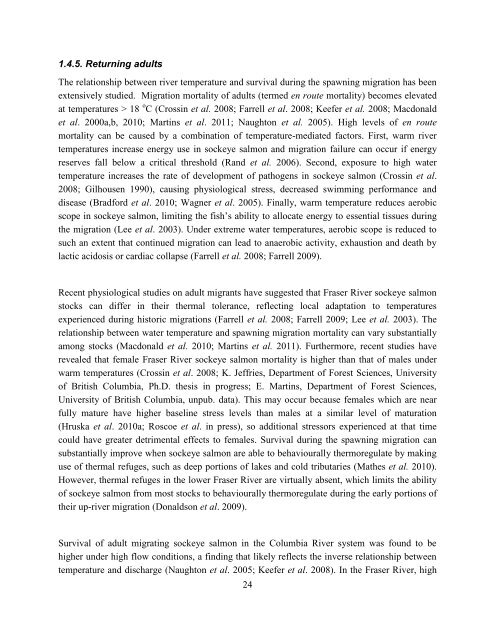Climate Change - Cohen Commission
Climate Change - Cohen Commission
Climate Change - Cohen Commission
Create successful ePaper yourself
Turn your PDF publications into a flip-book with our unique Google optimized e-Paper software.
1.4.5. Returning adults<br />
The relationship between river temperature and survival during the spawning migration has been<br />
extensively studied. Migration mortality of adults (termed en route mortality) becomes elevated<br />
at temperatures > 18 o C (Crossin et al. 2008; Farrell et al. 2008; Keefer et al. 2008; Macdonald<br />
et al. 2000a,b, 2010; Martins et al. 2011; Naughton et al. 2005). High levels of en route<br />
mortality can be caused by a combination of temperature-mediated factors. First, warm river<br />
temperatures increase energy use in sockeye salmon and migration failure can occur if energy<br />
reserves fall below a critical threshold (Rand et al. 2006). Second, exposure to high water<br />
temperature increases the rate of development of pathogens in sockeye salmon (Crossin et al.<br />
2008; Gilhousen 1990), causing physiological stress, decreased swimming performance and<br />
disease (Bradford et al. 2010; Wagner et al. 2005). Finally, warm temperature reduces aerobic<br />
scope in sockeye salmon, limiting the fish‟s ability to allocate energy to essential tissues during<br />
the migration (Lee et al. 2003). Under extreme water temperatures, aerobic scope is reduced to<br />
such an extent that continued migration can lead to anaerobic activity, exhaustion and death by<br />
lactic acidosis or cardiac collapse (Farrell et al. 2008; Farrell 2009).<br />
Recent physiological studies on adult migrants have suggested that Fraser River sockeye salmon<br />
stocks can differ in their thermal tolerance, reflecting local adaptation to temperatures<br />
experienced during historic migrations (Farrell et al. 2008; Farrell 2009; Lee et al. 2003). The<br />
relationship between water temperature and spawning migration mortality can vary substantially<br />
among stocks (Macdonald et al. 2010; Martins et al. 2011). Furthermore, recent studies have<br />
revealed that female Fraser River sockeye salmon mortality is higher than that of males under<br />
warm temperatures (Crossin et al. 2008; K. Jeffries, Department of Forest Sciences, University<br />
of British Columbia, Ph.D. thesis in progress; E. Martins, Department of Forest Sciences,<br />
University of British Columbia, unpub. data). This may occur because females which are near<br />
fully mature have higher baseline stress levels than males at a similar level of maturation<br />
(Hruska et al. 2010a; Roscoe et al. in press), so additional stressors experienced at that time<br />
could have greater detrimental effects to females. Survival during the spawning migration can<br />
substantially improve when sockeye salmon are able to behaviourally thermoregulate by making<br />
use of thermal refuges, such as deep portions of lakes and cold tributaries (Mathes et al. 2010).<br />
However, thermal refuges in the lower Fraser River are virtually absent, which limits the ability<br />
of sockeye salmon from most stocks to behaviourally thermoregulate during the early portions of<br />
their up-river migration (Donaldson et al. 2009).<br />
Survival of adult migrating sockeye salmon in the Columbia River system was found to be<br />
higher under high flow conditions, a finding that likely reflects the inverse relationship between<br />
temperature and discharge (Naughton et al. 2005; Keefer et al. 2008). In the Fraser River, high<br />
24

















